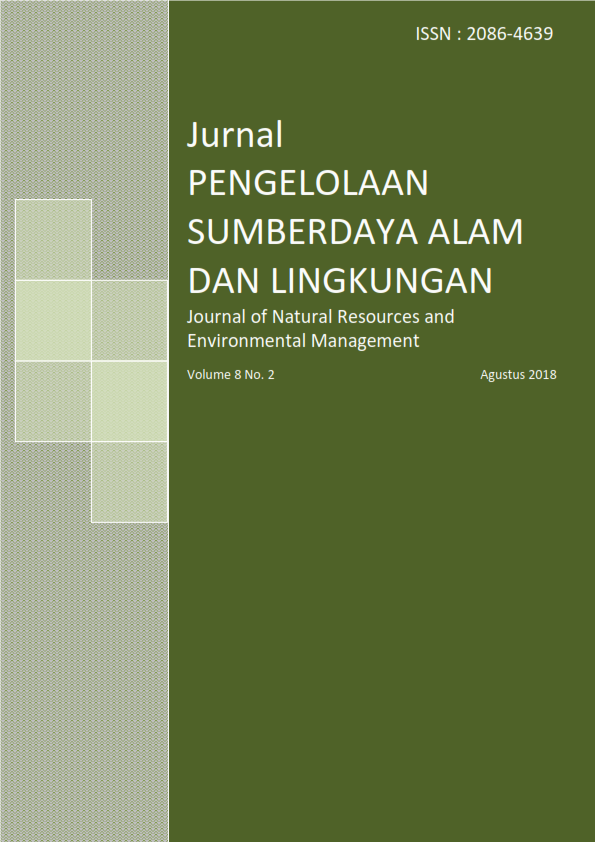NERACA KARBON, EMISI DAN SERAPAN HISTORIS CO2 KARENA PERUBAHAN PENGGUNAAN LAHAN DI KABUPATEN BANYUASIN, SUMATERA SELATAN
Abstract
References
Brown, S., 1997. Estimating Biomass and Biomass Change of Tripocal Forest. FAO Forestry Paper 134.
Donato, C.D., J. Kauffman, B. Murdiyarso, S. Kurnianto, M. Stidham, dan M. Kanninen, 2011. Mangroves among the most carbon rich forests in the tropics. Nature Geoscience. 4, pp. 293-297.
Duiker, S.W. and R. Lal, 2000. Carbon budget study using CO2 flux measurements from a no till system in central Ohio. Soil & Tillage Research. 54, pp. 21-30.
Hairiah, K., R.U. Sri, L. Betha, dan Meine van Noordwijk, 2004. Neraca Hara dan Karbon dalam Sistem Agroforestri. Bahan Ajaran Agroforestri 6. World Agroforestry Centre ICRAF, SEA Regional Office. Bogor.
Indonesian National Standard, 2011, “Ground Based Forest Carbon Accounting”. Indonesian National Standard Agency. 7724:2011, Jakarta.
IPCC, 1997. Revised 1996 IPCC Guidelines for National Greenhouse Gas Inventories. Volume 1: Reporting Instructions. Intergovernmental Panel on Climate Change.
IPCC, 2007, “Climate Change 2007: Synthesis Report. Contribution of Working Groups I, II and III to the Fourth Assess-ment Report of the Intergovernmental Panel on Climate Change” [Core Writing Team, Pachauri, R.K. and Reisinger, A. (eds.)]. IPCC, Geneva, Switzerland, 104 pp.
Jauhiainen, J., J. Heikkinen, P.J. Martikainen, H. Vasander, 2001. CO2 and CH4 fluxes in pristine peatswamp forest and peatland converted to agriculture in central Kalimantan, Indonesia. International Peat Journal. 11, pp. 43-49.
Jiao, J.G., L.Z. Yang, J.X. Wu, H.Q. Wang, H.X Li, E.C. Ellis, 2010. Land use and soil organic carbon in china’s village landscapes. Pedosphere. 20(1), pp. 1-14.
Lal, R., 2008. Carbon sequestration. Philos. Trans. R. Soc. London B. 63, pp. 815–830.
Lasco, R.D., 2004. Forest carbon budgets in southeast asia following harvesting and land cover change. Science in china series 3. 45, pp. 55-56.
Sing, S.K., C.B. Pandey, G.S. Sidhu, D. Sakar, R. Sagar, 2011. Concentration and stock of carbon in the soils affected by land uses and climates in the western Himalaya, India. Catena. 87, pp. 78-89.
Van Noordwijk, M., S. Dewi, N. Khasanah, A. Ekadinata, S. Rahayu, J.P. Caliman, M. Sharma, dan R. Suharto, 2010. Estimating the Carbon Foot print of Biofuel Production from Oil Palm: Methodology and Results from Two Sites in Indonesia. International Conference on Oil Palm and Environment, 23-25 Feb. 2010, Bali, Indonesia.
Wang, Z.P., X.G. Han, L.H. Li, 2008. Effects of grassland conversion to croplands on soil organic carbon in the temperate Inner Mongolia. J. Environ. Manage. 86, pp. 529-534.
Wibowo, A., K. Ginoga, F. Nurfatriani, H. Indartik, Dwiprabowo, S. Ekawati, H. Krisnawati, A. Siregar, 2010. REDD+ & Forest Governance. Pusat Penelitian Sosial Ekonomi dan Kebijakan Kehutanan Kampus Balitbang Kehutanan.
Authors
Authors who publish with this journal agree to the following terms:
- Authors retain copyright and grant the journal right of first publication with the work simultaneously licensed under a Creative Commons Attribution License that allows others to share the work with an acknowledgement of the work's authorship and initial publication in this journal.
- Authors are able to enter into separate, additional contractual arrangements for the non-exclusive distribution of the journal's published version of the work (e.g., post it to an institutional repository or publish it in a book), with an acknowledgement of its initial publication in this journal.
- Authors are permitted and encouraged to post their work online (e.g., in institutional repositories or on their website) prior to and during the submission process, as it can lead to productive exchanges, as well as earlier and greater citation of published work (See The Effect of Open Access).
Article Details
10.29244/jpsl.15.3.408






